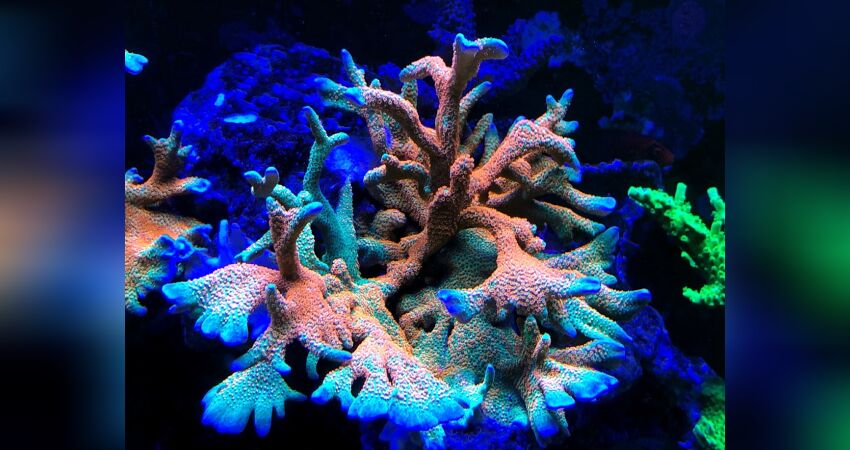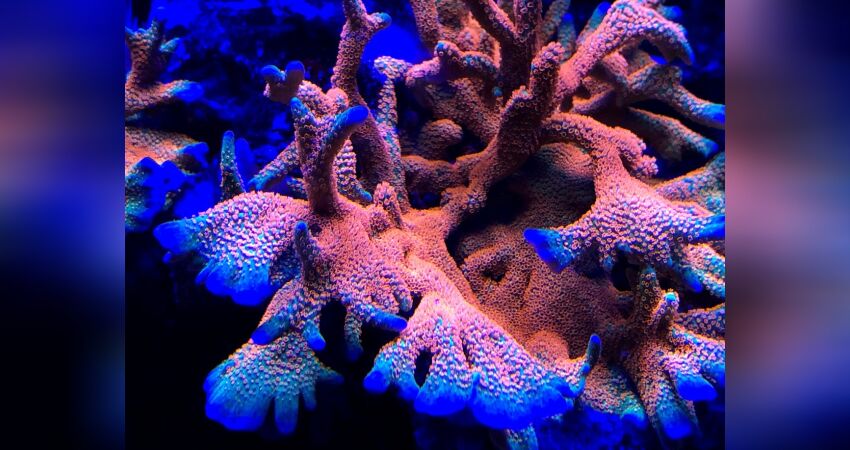How a marine aquarium is created Part 39: Montipora snails Phestilla sp.

Now it had hit us. The red Montipora, which had grown so well, showed pale colours and the first dead areas, preferably at the edges. You search and search and often only late come to the last possibility, namely that it is a predator that is attacking this beautiful coral. The certainty was there, we have Montipora snails! Enjoy the video and the article, which also offers some advice on what you can do.
I don't want to keep you in suspense for too long now, as I have packed most of it into the video. But I want to do a little bit of the development first.
The following image was taken in September 2019 and shows the Montipora in the top right of the image.
[image:17495]
The next image was taken in December
[image:17494]
Followed by images from August 2019. It's amazing what corals can grow in such a relatively short time. The following pictures were taken under blue light.


All of a sudden it started to grow. The picture now shows a pale coral with clear tissue recession. I took the pictures and asked the net for advice. I could have seen it earlier, but as it is when you only use your mobile phone, you just didn't see it there. I hope you enjoy the video that follows after the last three pictures.
[image:17498]
[image:17499]
[image:17500]
The VIDEO (with best thanks to Dennis Langbecker from the Montis Club)
Earlier this species was named Phyllodesmium, which does not seem to be correct. seems to be correct. Moreover, they are hardly distinguishable for us laymen, they are far too similar.
Worth knowing about this snail can be found below.
Excerpt from the marine encyclopaedia:
There are always reports of small whitish nudibranchs, which are called Montipora in our aquariums. observed in our aquariums as Montipora-eating pests. . Up to now, we have only been able to guess which species of nudibranch species of nudibranch.
During research on the Montipora nudibranchs that occur in marine aquarium nudibranchs that occur in marine aquaristics, we came across a scientific source, a doctoral thesis on the Internet, which deals nudibranchs of the genus Phestilla and their different and their different food in different areas of distribution. in detail.
Most of the nudibranchs of the genus Phestilla feed on Porites corals , few of Goniopora and Tubastrea. Scientific reports of a Montipora-feeding Phestilla we have for the first time from the scientific source mentioned above in 2016. were able to.
The Montipora-eating Phestilla, is referred to there as Phestilla sp.
. It was found in Bali on Montipora porites, on which it also feeds. it also feeds on. The Montipora-feeding Phestilla sp. is so far the nudibranch of its genus that feeds on Montipora corals. Montipora corals. We are curious when this species will be will be first described and included in WoRMS. Until then we list it here as Phestilla sp.
.
Hints that the Montipora pests in our aquariums are a nudibranch of the could be a nudibranch of the genus Embletonia or even Phestilla minor. Phestilla minor cannot be confirmed by the source and other scientific scientific reports. Phestilla minor feeds exclusively on Porites corals (Porites lutea) and other Phestilla cf minor feed on different Porites species. For Embletonia we found no scientific references.
The tiny nudibranchs are difficult to spot on their host corals. on their host corals. If you notice any damage, it is best to examine the coral examine the coral closely. The Montipora-feeding Phestilla sp. lays its numerous in clusters on Montipora's, according to some reports, on the underside of these on the underside of these stony corals .
How do you like this article?
Info
Author

Bookmark
Comments
Topics
Similar articles
- Photographing under blue light - 4 clip filters in comparison
- 15 - Part 2 Filter systems - Sludge filter
- 10 - Water, substrate and tank equipment
- Farbigkeit hermatypischer Steinkorallen
- visible colour change of corals due to more blue light and UV.
- 25 - Small polyp stony corals
- 36 - Pests Part 1
- Einsiedlerkrebse als Prophylaxe gegen Algenplagen? Teil 2
- Coral scions made easy - Markus Gerhardus shows us his breeding methods
- How a marine aquarium is created Part 38: When corals become entangled, the fight for settlement space
Comments To the top
Viele Grüße
Daniel
vielen Dank für Deinen Kommentar dazu. Ich hoffe wir bleiben vor Plagen verschont.
viele Grüße Robert
Please register
In order to be able to write something yourself, you must register in advance.







